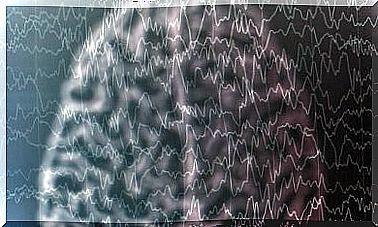Neurotic And Psychotic Defense Mechanisms

Defense mechanisms are automatic processes. They protect the individual from anxiety, the perception of internal and external dangers and stressors. They act as a buffer between the individual’s response to emotional conflict and internal or external stressors.
Although neurosis and psychosis have different opportunities to “coincide”, the mechanisms that control them are different. The main difference lies in their relation to reality and their way of constructing this reality. In the context of neurosis, fantasy reigns as a response to a point of fixation. In that of psychosis, on the other hand, it is a complete substitution that reigns and seeks to restore a previous denial.
Specific neurotic defense mechanisms
Repression
It is a mechanism used by the ego to prevent anxiety-generating thoughts from reaching consciousness. It is the most basic defense mechanism. For another defense mechanism to trigger, it must first be applied.
Move
It consists of replacing our true desire, which causes anxiety and is intolerable, with another desire which does not produce it and which is acceptable. This mechanism may explain why we can sometimes suddenly develop a phobia. For example, if we feel dirty and ashamed to express it, our disgust and phobia towards cockroaches can develop.

Neurotic defense mechanisms based on identification
Identification
It is a psychological process of strengthening our feelings of self-worth by adopting the characteristics of someone we admire.
Projective identification
It is a mechanism described by Mélanie Klein. It refers to the fantasies employed by a subject when he projects his own characteristics (totally or partially) onto an object in order to gain control, damage or possess it.
Identification with the aggressor
Anna Freud and Ferenczi described this mechanism. In this case, the subject projects onto himself certain characteristics of the person which generates anxiety in him. He is no longer the threatened individual and becomes the threatening individual.
Projection
It is a mechanism through which we attribute our unrecognized and distressing personal characteristics to another person or object. It is a type of defense that is identifiable in cases of psychosis, neurosis and perversion.
Introjection
This mechanism was written by Ferenczi. It is an unconscious process by which an individual incorporates into himself the characteristics of others that are not suited to him. For example, a depressed person may take credit for another person’s attitudes and sympathy.
The identification would actually correspond to the “healthy” version of this mechanism. It involves adopting the desirable characteristics of others. The introjection would mean “swallowing them without digesting them” which would end up creating an unbalanced being.
Defense mechanisms based on the transformation of impulses
Reaction training
Reaction training is a mechanism by which censurable thoughts are repressed and expressed through their opposites. This defense mechanism would explain in particular the mania which would hide a repressed depression.
Substitution or substitute training
It is a mechanism through which we suppress any libidinous behavior by substituting it with another more acceptable and conscious behavior. Thus, one can satisfy a forbidden pleasure in a disguised manner. This may be the case in a person who feels revulsion towards their partner. When she cannot accept the situation, she suppresses her emotion and expresses it in the form of an allergic reaction.
Sublimation
It is a mechanism that seeks to replace an unacceptable object or activity with another object or activity of higher social or ethical value.
Rationalization
It is the rational justification for thoughts or behaviors that produce anxiety. It differs from intellectualization. Rationalization does not imply the systematic avoidance of affection. She attributes to it more plausible than true motivations, giving it a rational or ideal justification.
Intellectualization
In this case, the individual tries to provide a discursive formulation of his conflicts and emotions in order to control them. This mechanism is associated with the emotional isolation that would normally accompany a painful event, with a rational explanation.
Defense mechanisms based on repression or disguise of the drive
Isolation
It is a mechanism through which one consciously separates from the troublesome representation of affection by depriving oneself of any associative connection. This can for example develop in a child victim of abuse. He feels anxious but unable to make the connection between the two elements.
The formation of a commitment
This corresponds to a deformation of the repressed element that can manifest itself in different ways: in dreams, in symptoms, or in certain artistic productions.
Cancellation or retroactive cancellation
According to Freud, it is an active process which consists in detaching yourself from what you have done. The individual tries to convince himself that a reasoning or an act never took place.
The transformation (of a drive) into its opposite
It consists in transforming the result of the drive into its opposite. We transform the result of the drive, not the object by means of which it is satisfied.
If my partner abandons me, the love I felt for him turns to hate. I now feel hatred for the object for which I previously felt love. The drive changed, but the object (my partner) remained the same.

Specific psychotic defense mechanisms
Denial
According to Freud, this mechanism consists in eliminating a troublesome representation not by erasing it (cancellation), nor by refusing to recognize that it belongs to us (negation). It is about denying the very reality of the perception associated with this representation.
Doubling of the ego
It is a psychotic defense mechanism against dissociation and death anxiety. A part of the ego would therefore remain in operative contact with the reality which does not disturb. The other part of the ego would lose all contact with this reality. She would thus reject all the too distressing aspects and if necessary, would rebuild by way of compensation a new reality more tranquil and desired (through delirium).
Duplication of perceptions
This is the mechanism of limit states. It helps to fight against the anxiety associated with the loss of an object and to put aside disturbing representations.
A person who projects a bad part of their reality onto another, but without losing touch with them, is a good example. In this case, the split does not imply a loss of contact with reality.
Renunciation or exclusion
Foreclosure is a term used by Lacan to refer to exclusion. This supposes the rejection of the primordial meaning in the constitution of the child as an individual different from his mother. This therefore condemns the child not to become a subject of the pre-existing linguistic universe and predisposes him to psychosis.
Defense mechanisms fall into different groups which are related to levels of defensive functioning. In the context of neuroticism, these defense mechanisms are articulated as protectors against a reality that is not tolerated, even if it is always linked to it.
However in psychosis, the distressing reality is never tolerated and the defense mechanisms are articulated by leaving the person alone in contact with the desired or imagined reality and depriving him of contact with the harsh reality in order to try to stabilize his emotions. . Sometimes this emotional stability is achieved through building delirium.










